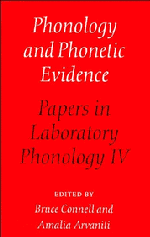Book contents
- Frontmatter
- Contents
- List of contributors
- Acknowledgments
- 1 Introduction
- I Features and Perception
- II Prosody
- 8 Stress shift: do speakers do it or do listeners hear it?
- 9 The phonology and phonetics of the Rhythm Rule
- 10 The importance of phonological transcription in empirical approaches to “stress shift” versus “early accent”: comments on Grabe and Warren, and Vogel, Bunnell, and Hoskins
- 11 Perceptual evidence for the mora in Japanese
- 12 On blending and the mora: comments on Kubozono
- 13 Toward a theory of phonological and phonetic timing: evidence from Bantu
- 14 On phonetic evidence for the phonological mora: comments on Hubbard
- III Articulatory Organization
- Subject index
- Index of names
- Index of languages
9 - The phonology and phonetics of the Rhythm Rule
Published online by Cambridge University Press: 03 May 2011
- Frontmatter
- Contents
- List of contributors
- Acknowledgments
- 1 Introduction
- I Features and Perception
- II Prosody
- 8 Stress shift: do speakers do it or do listeners hear it?
- 9 The phonology and phonetics of the Rhythm Rule
- 10 The importance of phonological transcription in empirical approaches to “stress shift” versus “early accent”: comments on Grabe and Warren, and Vogel, Bunnell, and Hoskins
- 11 Perceptual evidence for the mora in Japanese
- 12 On blending and the mora: comments on Kubozono
- 13 Toward a theory of phonological and phonetic timing: evidence from Bantu
- 14 On phonetic evidence for the phonological mora: comments on Hubbard
- III Articulatory Organization
- Subject index
- Index of names
- Index of languages
Summary
Introduction
The Rhythm Rule, the phenomenon responsible for the perceived rhythmic adjustment of adjacent stresses in such items as thirtéen and Tennessée vs. thírteen wómen and Tennessée législature, has received much attention in recent years from both the phonological and phonetic points of view. In this paper, we address issues relating to both the phonology and phonetics of the Rhythm Rule, and in particular, the relation between the two. Our investigation shows how the phonetic analysis of a phonological rule can provide insight where phonological analysis by itself is inconclusive. Finally, in our phonetic analysis, we not only investigate production data, but also data relative to the perception of our speech samples in order to determine how particular acoustic correlates of the Rhythm Rule are interpreted by listeners.
Background and issues addressed
Phonology
Of primary concern here are two treatments of the Rhythm Rule (RR) that have received broad acceptance, and which we will refer to as the Reversal Analysis (RA) and the Deletion Analysis (DA). According to the Reversal Analysis, when a clash arises between adjacent word stresses, the RR applies to alleviate this clash by shifting the primary stress of the first word from the final syllable to an earlier syllable in the word (e.g. Liberman, 1975; Liberman & Prince, 1977; Hayes, 1984), as illustrated in (1), where the level 3 grid marks indicate primary stress.
- Type
- Chapter
- Information
- Phonology and Phonetic EvidencePapers in Laboratory Phonology IV, pp. 111 - 127Publisher: Cambridge University PressPrint publication year: 1995
- 14
- Cited by

